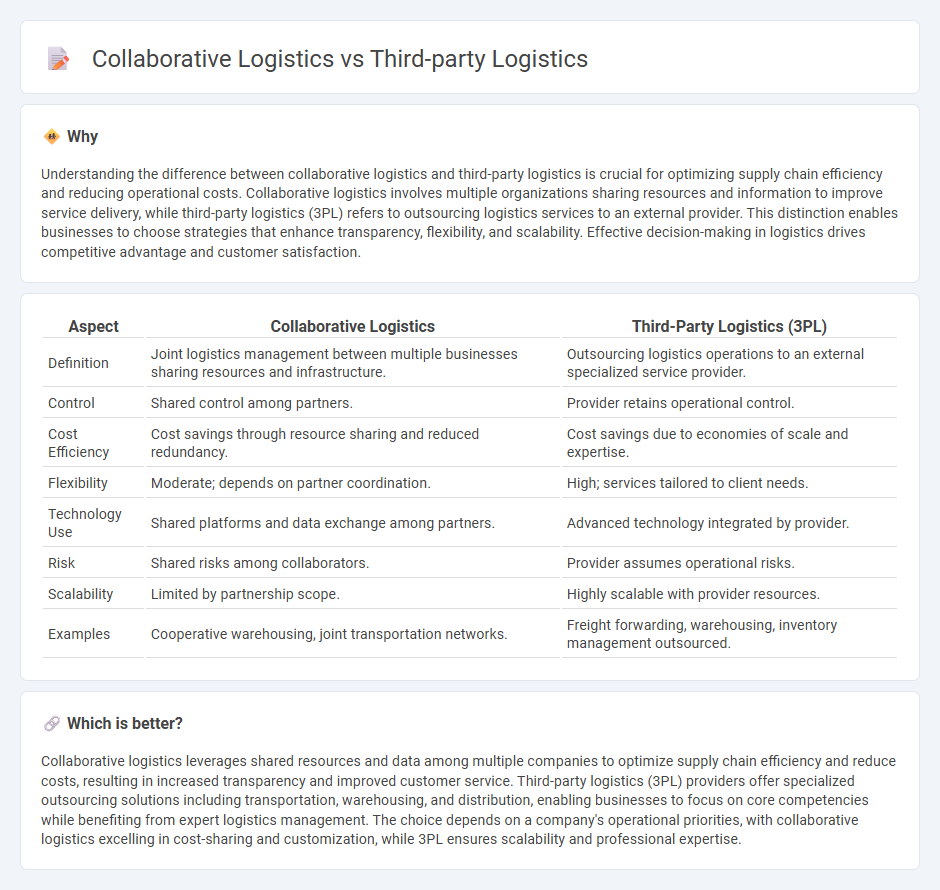
Collaborative logistics leverages shared resources and information among multiple businesses to optimize supply chain efficiency, reduce costs, and improve delivery speed. Third-party logistics (3PL) involves outsourcing logistics functions to specialized service providers who manage transportation, warehousing, and distribution. Explore how both approaches can transform your supply chain strategy and enhance operational performance.
Why it is important
Understanding the difference between collaborative logistics and third-party logistics is crucial for optimizing supply chain efficiency and reducing operational costs. Collaborative logistics involves multiple organizations sharing resources and information to improve service delivery, while third-party logistics (3PL) refers to outsourcing logistics services to an external provider. This distinction enables businesses to choose strategies that enhance transparency, flexibility, and scalability. Effective decision-making in logistics drives competitive advantage and customer satisfaction.
Comparison Table
| Aspect | Collaborative Logistics | Third-Party Logistics (3PL) |
|---|---|---|
| Definition | Joint logistics management between multiple businesses sharing resources and infrastructure. | Outsourcing logistics operations to an external specialized service provider. |
| Control | Shared control among partners. | Provider retains operational control. |
| Cost Efficiency | Cost savings through resource sharing and reduced redundancy. | Cost savings due to economies of scale and expertise. |
| Flexibility | Moderate; depends on partner coordination. | High; services tailored to client needs. |
| Technology Use | Shared platforms and data exchange among partners. | Advanced technology integrated by provider. |
| Risk | Shared risks among collaborators. | Provider assumes operational risks. |
| Scalability | Limited by partnership scope. | Highly scalable with provider resources. |
| Examples | Cooperative warehousing, joint transportation networks. | Freight forwarding, warehousing, inventory management outsourced. |
Which is better?
Collaborative logistics leverages shared resources and data among multiple companies to optimize supply chain efficiency and reduce costs, resulting in increased transparency and improved customer service. Third-party logistics (3PL) providers offer specialized outsourcing solutions including transportation, warehousing, and distribution, enabling businesses to focus on core competencies while benefiting from expert logistics management. The choice depends on a company's operational priorities, with collaborative logistics excelling in cost-sharing and customization, while 3PL ensures scalability and professional expertise.
Connection
Collaborative logistics enhances supply chain efficiency by enabling multiple stakeholders to share resources, data, and transportation activities, reducing costs and improving delivery speed. Third-party logistics (3PL) providers often facilitate these collaborative efforts by offering integrated warehousing, transportation, and inventory management services tailored to diverse partners. The synergy between collaborative logistics and 3PL creates a more flexible, scalable, and optimized supply chain network for businesses across industries.
Key Terms
Outsourcing
Third-party logistics (3PL) involves outsourcing supply chain management tasks to external providers specializing in warehousing, transportation, and fulfillment services. Collaborative logistics emphasizes joint efforts among multiple stakeholders to optimize resources and improve efficiency through shared data and infrastructure. Explore detailed comparisons to understand which outsourcing model best suits your business needs.
Integration
Third-party logistics (3PL) involves outsourcing supply chain management to specialized providers, offering scalable solutions with standardized integration through APIs and EDI for seamless data exchange. Collaborative logistics emphasizes real-time integration among multiple stakeholders, enhancing transparency, demand forecasting, and resource optimization via shared digital platforms and IoT connectivity. Explore how advanced integration strategies in these logistics models drive efficiency and innovation across global supply chains.
Information Sharing
Third-party logistics providers specialize in managing transportation, warehousing, and distribution independently, often limiting information exchange to transactional data. Collaborative logistics emphasizes real-time information sharing across all supply chain partners, enhancing transparency, coordination, and responsiveness. Discover how leveraging integrated data platforms can revolutionize your supply chain efficiency through information sharing.
Source and External Links
What is 3PL (third-party logistics)? - A 3PL provider offers outsourced logistics services, which can include anything from warehousing and transportation to comprehensive supply chain management, enabling businesses to focus on their core activities while leveraging specialized expertise and infrastructure.
What is a 3PL? Third-Party Logistics Process Explained - Businesses use 3PLs to handle order fulfillment, warehousing, and shipping, streamlining logistics operations and potentially reducing costs through economies of scale and efficient shipping practices.
 dowidth.com
dowidth.com